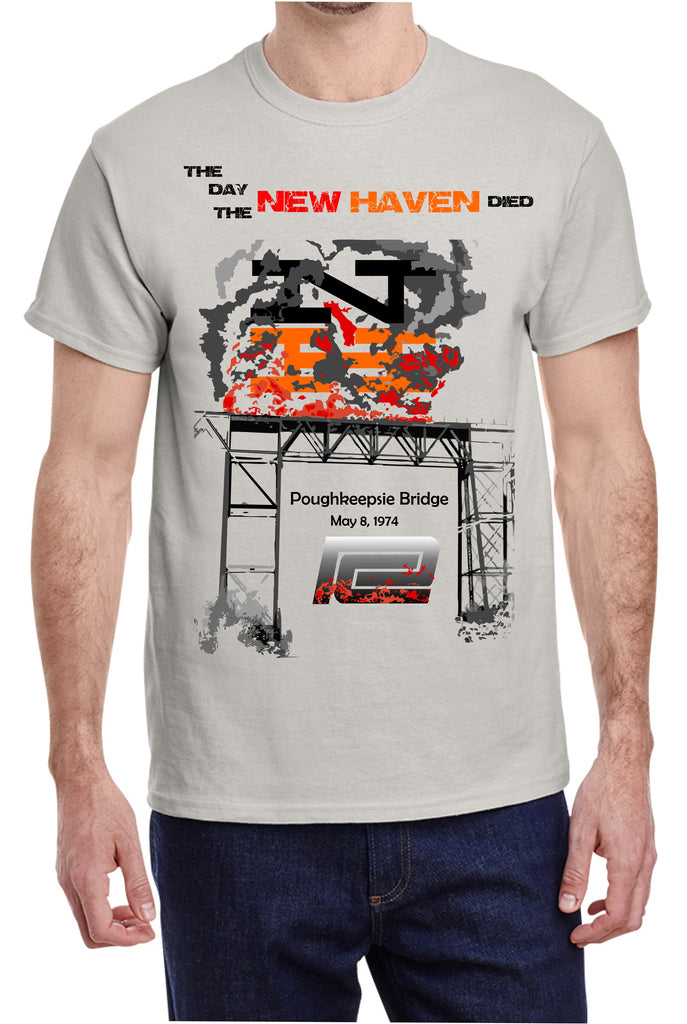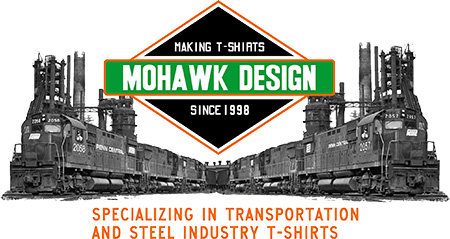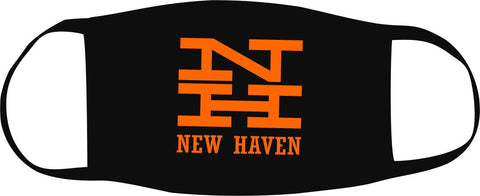
New Haven "Poughkeepsie Bridge" Fire Logo Shirt
New Haven "Poughkeepsie Bridge" Fire Logo Shirt
- Logo Printed on Front
- 100% Cotton
- Shirt Color - Ice Grey
In 1868, an engineer proposed a railroad bridge across the Hudson River at Poughkeepsie, in a letter published in the Poughkeepsie Eagle newspaper. The proposal seemed so absurd that the Eagle ridiculed it, and it was effectively forgotten for a few years.[12][13]
Over the years, many plans had been made for a fixed span across the Hudson River south of Albany to replace numerous car float and ferry operations. One of the most persistent was originally chartered in 1868 as the Hudson Highland Suspension Bridge Company, whose proposed bridge would have crossed from Anthony's Nose to Fort Clinton, now roughly the site of the Bear Mountain Bridge. It was never built.
The Poughkeepsie Bridge Company was chartered in June 1871 to build the bridge, and J. Edgar Thomson of the Pennsylvania Railroad was persuaded to support the effort. Contracts were let to a firm called the American Bridge Company (not the company of the same name founded later), but the Panic of 1873 intervened and the scheme collapsed.
In 1886, the Manhattan Bridge Building Company was organized to finance the construction. Among the prominent backers was Henry Clay Frick, the coal tycoon and associate of Andrew Carnegie. The Union Bridge Company of Athens, Pennsylvania, which had completed the Michigan Central cantilever bridge at Niagara (see Niagara Cantilever Bridge), was subcontracted to build the Poughkeepsie Bridge. Dawson, Symmes and Usher were the foundation engineers, while John F. O'Rourke, P. P. Dickinson and Arthur B. Paine were the structural engineers. The bridge was designed by Charles Macdonald and Arthur B. Paine. As is typical for cantilever bridges, construction was carried out by constructing cribwork, masonry piers, towers, fixed truss sections on falsework, and finally cantilever sections, with the final cantilever interconnection (suspended) spans floated out or raised with falsework. The first train crossed the bridge on December 29, 1888, and it was formally opened for scheduled passenger service on January 1, 1889.
Considered an engineering marvel of the day, the bridge has seven main spans. The total length is 6,768 feet (2,063 m), including approaches, and the top of the deck is 212 feet (65 m) above water. It is a multispan cantilever truss bridge, having two river-crossing cantilever spans of 548 feet (167 m) each, one center span of 546 feet (166 m), two anchor (connecting) spans of 525 feet (160 m), two shore spans of 201 feet (61 m) each, a 2,641 feet (805 m) approach viaduct on the eastern bank and a 1,033 feet (315 m) approach viaduct on the western bank. All seven spans were built of newly available Bessemer Process "mild" (between 0.16% and 0.29% carbon) steel, while the two approach viaducts were built of iron. It formed part of the most direct rail route between the industrial northeastern states and the midwestern and western states
Traffic across the bridge began a slow decline in the 1950s as industry shrank in New England and with it the need for the raw materials railroads excelled at transporting. Traffic from the connecting New York, Ontario & Western ceased when that railroad shut down on March 30, 1957. Another connection, the coal-, slate-, and cement-hauling Lehigh & New England, shut down in 1961. At the same time, some new traffic began crossing the bridge, such as the New Haven's "Super Jet", one of the first trains to carry truck trailers. The Penn Central's acquisition of the New Haven in 1969 discouraged connecting traffic with the Erie Lackawanna, which competed with other Penn Central routes. After 1971, only one through train in each direction, for Erie Lackawanna, crossed the bridge.[20]
While the Penn Central did not connect with the old New Haven on the west side of the bridge, it came close. For a short time in 1969 and 1970, Penn Central ran a daily train between Cedar Hill Yard in New Haven, Connecticut and Potomac Yard in Alexandria, Virginia, by way of the Lehigh and Hudson River Railway, which connected with the Penn Central Belvidere Division in Belvidere, New Jersey, 72 miles south of the old interchange with the New Haven at Maybrook Yard in Maybrook, New York. The service ended in a dispute over haulage charges and the traffic was diverted to the longer all-Penn Central route through Selkirk, New York. Ironically, the only reason the Lehigh and Hudson River was not part of the Penn Central was because a Penn Central predecessor, the Pennsylvania Railroad, had prevented the New Haven from acquiring it in 1905.[20] The Lehigh and Hudson River and Erie Lackawanna were finally joined with the Penn Central when all were taken over by Conrail in 1976.
On May 8, 1974, a tie fire damaged about 700 feet (210 m) of decking and underlying girders on the bridge's eastern section.[21] It was likely started by a spark from an eastbound freight train that had just crossed the span.[22] The Penn Central had neglected the bridge's fire-protection system, which had no water on the day of the fire, and had laid off employees who kept watch for such fires.[12] A photograph of the last train, a run-through from the Erie Lackawanna, was included in a 40th anniversary web feature by the Poughkeepsie Journal.[23]
In August 1974, the Penn Central applied for $1.75 million to repair and improve the bridge from the federal government through the Regional Rail Reorganization Act of 1973.[24] By 1975, efforts had shifted to acquiring a combination of state and railroad funding. In November 1975, a formal agreement between the New York State Department of Transportation and the trustees of the Penn Central was approved, allowing the $359,000 insurance payout for the bridge to be spent on repairs, with the state paying the rest. In December, U.S. Representative Benjamin A. Gilman announced that $486,000 appropriated by the state legislature for repairs was undergoing final review by the state.[25] Authorization for the state to spend its share on bridge repairs had still not been given when, on April 1, 1976, ownership of the bridge changed with the inception of Conrail.[26] Having been forced to include the route over the bridge (the Maybrook Line) in its new system at the behest of Connecticut Senator Abraham Ribicoff, Conrail announced that it would not promise to repair and use the bridge despite a Connecticut foundation's offer to pay half the repair cost if the bridge were used again. The railroad further said that other work required to make the route usable would raise the reactivation cost to $45.8 million.[27][28]
Seven years passed; pieces of the bridge's eastern approach viaduct over Poughkeepsie began falling onto U.S. Route 9 below, damaging passing vehicles. In response, the city sued Conrail and forced it to spend $300,000 in 1983 to remove the decking over the superstructure. Conrail then sought to dispose of the unused bridge and eventually abandoned and tore up the Maybrook Line between Hopewell Junction and Maybrook, New York in 1983–1984




